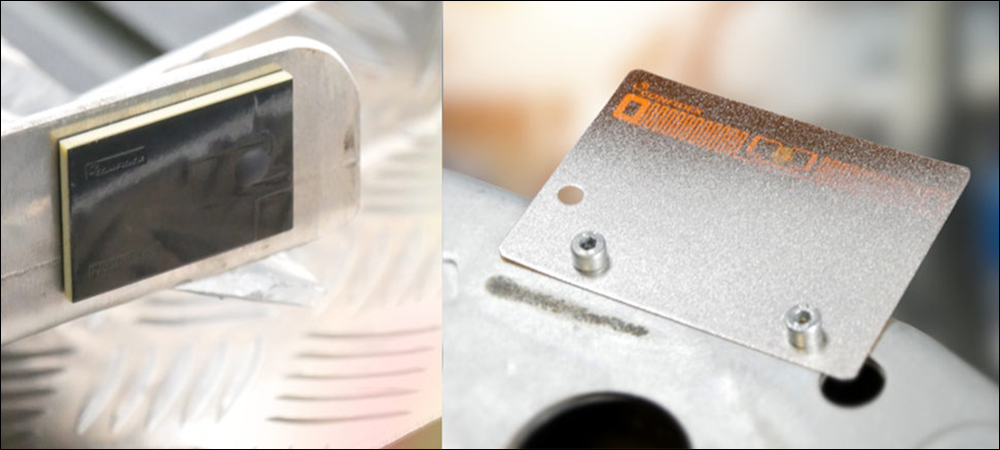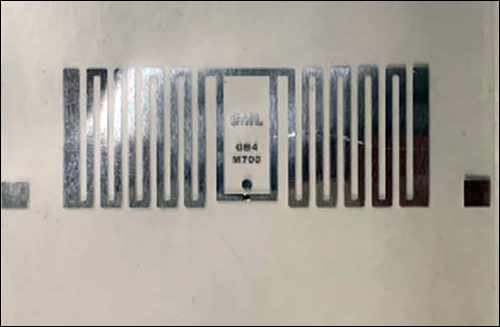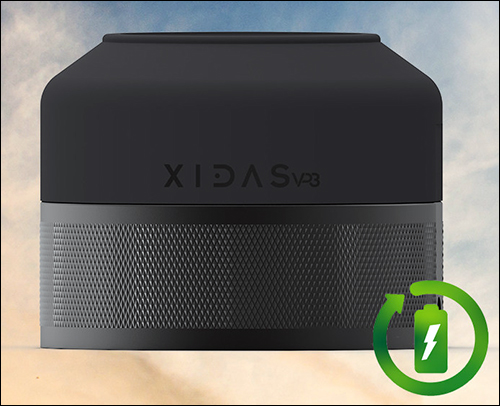Oct 22, 2020Presented here are recent news announcements regarding the following organizations: Confidex, Portable Technology Solutions, ClearStream, SML, Convergence Systems Ltd., Intrasonic Technology, Lenovo, Senet, Xidas, STMicroelectronics, SOMOS Semiconductor, WISER, and the UWB Alliance.
Confidex Unveils Heat-Resistant UHF RFID Tags
Confidex, a provider of wireless solutions for the public-transportation, logistics, automotive and manufacturing industries, has announced two products aimed at the automotive sector. Its Heatwave family of UHF RFID tags is designed for the automated tracking of goods through the high-temperature phases of automotive production. The Heatwave Flag includes flexible attachment for paint-shop processing, the company reports, while the Heatwave Tough provides strong performance on metallic surfaces.
The Heatwave products can be applied to automobile bodies to control the production process for each individual body configuration. The tags feature a special polymer design and can operate at temperatures of up to 250 degrees Celsius (482 degrees Fahrenheit) in body and paint shops. The tags are intended to reduce the need for scanning interfaces and prevent redundant identification processes at manufacturing sites, Confidex reports, while tags that remain on a product or asset after production offer after-sales benefits for consumers and retailers.

The Heatwave Flag has been upgraded from the Corona Classic model, with increased memory and sensitivity. Its attachment design enables it to be fixed to all materials, the company reports, while it can be applied so that the antenna does not come in direct contact with metal. The Heatwave Tough is built for attachment on flat metal surfaces, while offering flexible tag positioning and automated application. It comes with heat resistance of 250 degrees for 50 minutes; operates in the presence of salt water, motor oil, acetone, sulfuric acid and other chemicals; and features NXP's UCODE 7xm+ chip with a 384-bit digital signature and 2 kilobytes of user memory.
According to Confidex, its VDA-compliant solution has helped Volvo and other automotive companies improve flexibility and manufacturing processes in their global production networks. The Heatwave products can also be used for other industrial manufacturing processes involving temperatures of up to 250 degrees. The tags are available now for samples and commercial production.
PTS Updates ClearStream Software
Portable Technology Solutions (PTS) recently launched its ClearStream RFID 6.0 platform. The newest iteration of the company's RFID software features greater data-collection capability and offers flexibility for both developers and non-developers, the company reports. ClearStream RFID 6.0 includes a cloud-based RFID reader portal, offline data-protection technology and Bluetooth Low Energy (BLE) zone tracking. The software offers an optional connection to the PTS cloud, enabling users to view and manage RFID and BLE data from dispersed locations.
PTS provides user-configurable data-collection software and systems, including TracerPlus mobility software and ClearStream fixed RFID software. Its solutions require no programming experience, the company reports, enabling their configuration, deployment and use by those with varying experience levels. Headquartered in New York, the firm maintains an active presence in Europe and partners with hardware manufacturers, distributors and OEM solution providers.
ClearStream's On-Board software lets users configure and control their RFID and BLE readers remotely via a cloud-based portal. The software is hardware-agnostic and supports multiple RFID and BLE devices, in order to help users avoid losing data due to network failures. Information is stored locally during such failures and is then streamed to a customer's database once a connection is reestablished. ClearStream RFID 6.0 adds support for BLE zone locating. With this feature, companies can track high-value assets throughout large sites via a real-time locating system that allows them to view where those items are at any given time.
"Our goal for ClearStream has always been to offer affordable, highly configurable and intuitive software that utilizes the latest passive data collection technology," said Brad Horn, PTS's CEO and cofounder, in a prepared statement. "ClearStream 6.0 solves two fundamental problems this technology traditionally faces: losing data because of network outages, and the difficulty of deploying RFID and BLE hardware to dispersed locations."
SML Offers New RFID Inlay for Retail
SML RFID, a provider of radio frequency identification solutions for the retail market, has announced the release of its GB4M700 inlay. The new inlay is designed to help retailers boost efficiency and reduce material and shipping costs, the company reports. It measures 42 millimeters by 16 millimeters (1.7 inches by 0.6 inch).

According to the company, the inlay's size and efficiency are intended to increase inventory accuracy and management for omnichannel retailers. The GB4M700 inlay offers read sensitivity of -24 dBm, with a small antenna and up to 128 bits of Electronic Product Code (EPC) chip memory. The inlay can be fitted onto most tagged products, the firm reports, thereby improving the consistency of read performance for inventory tracking in large-scale retail deployments.
In addition to supporting clothing and denim tags, the inlay supports the tagging of polybags and boxed items. "SML RFID is committed to delivering the most innovative solutions to empower retailers to better manage their inventory," said Dean Frew, SML Group's chief technology officer and senior VP of RFID solutions, in a prepared statement. "As a result, we are continuing to invest in our technology.
CSL, Intrasonic Technology Form RFID Distribution Partnership
RFID equipment supplier Convergence Systems Ltd. (CSL) has signed an agreement with Intrasonic Technology (IST) to become the exclusive distributor in the Americas for CSL's line of RFID products. This joint marketing venture will enable CSL to provide its RFID products to systems integrators throughout the Americas. The partnership between IST and CSL is intended to provide UHF RFID products for hundreds of use cases in dozens of industries.
Robert Pinell, Intrasonic Technology's president, noted in a prepared statement that IST will stock and distribute CSL's RFID product line, including the CS108 Bluetooth Handheld Sled Reader and the CS463 Intelligent Fixed Reader. "We'll provide all the product services a reseller requires," Pinell added in the statement, "including product support, warranty resolution and repair. IST-RFID can also provide drop-shipping, configuration and kit-bundling for resellers' unique projects."
"We couldn't be happier to team up with Intrasonic to ensure a streamlined distribution and support service for all our products in the Americas," said Jerry Garrett, CSL's managing director, in the prepared statement. Pinell added, "We're extremely excited with this new partnership with CSL and believe we will provide a fantastic new resource for a wide range of customers in the Americas."
Lenovo Releases Retail IoT Pandemic Solutions
Lenovo has announced its ThinkIoT Smarter Store solutions, designed to help brick-and-mortar stores adapt to the COVID-19 pandemic. The solutions are intended to improve inventory availability, product interaction and labor efficiency, the company reports, and to make stores safer for shoppers during the pandemic. According to Lenovo, a recent survey found that nearly half of its consumers have begun shopping online more frequently, while 66 percent believe it's a retailer's responsibility to keep them healthy while they shop in-store.
"Brick-and-mortar retailers offer a unique experience for shoppers that cannot be fully replicated online," said John Gordon, the president of Lenovo's CIoT Business Group, in a prepared statement. "We're helping these important retail businesses create even more differentiated customer experiences, while improving their bottom line so they can continue to grow during challenging economic times." The ThinkIoT solutions are tested and validated to address stores' customer-experience, productivity and safety needs, the firm explains. Lenovo has worked with several hardware and software partners to create these offerings, including Avalue, L Squared, Spacee, and Viper Imaging.
The solutions are intended to increase store visits through targeted advertising and the tracking of in-store marketing effectiveness, via custom QR codes from digital displays; drive inventory productivity by making inventory management more efficient with out-of-stock detection, inventory counts, planogram compliance, and price checking leveraging smart shelves and smart pushers; and boost customer purchase rates by letting shoppers learn about products via smart displays with interactive product information and tailored ads. The solution utilizes FDA-certified temperature-screening technology to keep sick employees from entering a store, while communicating policy changes, mask requirements and occupancy levels to customers via digital signs.
ThinkIoT features validation processes for software that includes up to 140 steps covering security, serviceability, scalability and reliability, as well as a field network of more than 20,000 technicians for global deployment. The company's point-of-sale and self-service kiosk solutions help retailers expand beyond siloed digital point tools, as well as reduce hardware footprints and expenses through connected self-service solutions. In addition, Lenovo's AI Innovation Centers help users optimize their businesses with analytics and machine-learning capabilities, so they can understand customer behavior, reduce shrinkage, and meet complex logistics and inventory challenges.
Senet Offers IoT LoRaWAN Network-Management Tools
Senet, a provider of cloud-based software and service platforms designed to enable connectivity and network build-outs for the Internet of Things (IoT), has announced a suite of radio access network (RAN) planning and management tools, business-development programs, and co-marketing initiatives to support the deployment of commercial LoRaWAN solutions. According to the company, this is intended to broaden the opportunity for infrastructure providers and other physical asset owners to participate in the IoT services economy.
Senet's RAN Provider tools provide network operators, tower companies, municipalities, building owners and solution providers with the resources required to rapidly design and deploy carrier-grade LoRaWAN networks, both indoors and outdoors, from a dedicated RAN Provider Portal. Alternatively, users can contract RAN deployment services from Senet on an as-needed basis. The tools are available in more than 80 countries in which the firm offers coverage and connectivity. The portal enables users to plan, monitor and manage critical infrastructure, network and assets, including network design and RF planning, such as gateway placement, end-node coverage simulation, and redundancy strategies and planning.
The portal provides continuous real-time monitoring of system and network health; reporting on the aggregation of alerts, either network-wide or by individual asset; and case management for the generation and tracking of support cases from individual alerts. Optional services to assist with network planning and deployment include RAN site evaluation and acquisition services, such as location planning, permitting, and power and backhaul analysis; as well as RAN deployment services for gateway hardware acquisition, provisioning, staging, installation and onboarding to Senet's network server.
"To support the scale and operational complexities of the IoT, legacy network architectures and business models are being replaced with cloud-based services, innovative RAN deployment models, and partner engagements that allow companies of all types to participate in the IoT economy," said Bruce Chatterley, Senet's CEO, in a prepared statement. "A shared RAN infrastructure is a key step toward delivering lower connectivity costs and interoperability, and we're committed to providing tools that enable our RAN partners to deliver robust network services under a mutually beneficial financial model."
Senet is also offering RAN partner programs to facilitate engagement between network infrastructure companies and IoT solution providers. Initiatives include the coordination of ecosystem engagements for regional and national solution deployment, collaborative promotions in support of public network readiness, and network-branding opportunities.
Xidas Solution Addresses IoT Sustainability
Technology startup Xidas has introduced its Vibration Perpetual Power Pod, also known as the VP3, to reduce the level of toxic chemicals leached into soil and landfills after sensor batteries have exhausted their life. The VP3 is designed to provide sensors with 10 years of lifetime or more, the company reports, by capturing energy from small vibrations in the environment. The company views its new energy harvester as a way to power the IoT in a more efficient and sustainable manner, it reports, by diminishing the need for users to frequently replace and dispose of batteries.
Xidas designs and produces edge solutions that provide intelligence, zero-power energy harvesting, sensor fusion and integration. With experience in 3D manufacturing and micro-engineering, the company is a partner of the U.S. National Science Foundation for IoT innovation and was one of five businesses that testified before the U.S. Congress regarding the value of IoT technologies.

The Internet of Things connects billions of sensors to monitor devices and gather insights. Many of these sensors are wireless in nature, in order to increase the number of locations in which they can be deployed. In such an environment, the firm indicates, battery replacement can lead to a major issue involving the disposal of used batteries. Some contain toxic metals, such as cadmium, mercury, lead and lithium, which become hazardous waste products and pose threats to health and the environment if improperly disposed of.
Thus, Xidas offers self-charging batteries designed to minimize the number of batteries that end up in landfills, thereby increasing battery life and reducing the need for replacement. The VP3 is designed to convert energy from small machine vibrations into power for wireless sensors that perform machine-condition monitoring and predictive maintenance of industrial assets.
STMicroelectronics Acquires SOMOS Semiconductor
Semiconductor company STMicroelectronics has announced its acquisition and integration of the assets of SOMOS Semiconductor, a French fabless semiconductor company specializing in silicon-based power amplifiers and RF front-end modules (FEM) products for the cellular Internet of Things (IoT) and 5G markets. With this acquisition, ST says it hopes to strengthen its capacity to develop and offer standalone and STM32-based connectivity solutions. The terms of the transaction have not been disclosed.
ST works with customers and partners worldwide to design and build products, solutions and ecosystems. Its technologies are intended to enable smarter mobility and more efficient power and energy management, the company reports, as well as the widescale deployment of 5G and IoT solutions. A new product, an NB-IoT/CAT-M1 module, is already undergoing qualification following the acquisition, and is expected to be the first of several new connectivity RF FEM products that ST will offer. SOMOS's technology and assets will support the development of ST's existing RF front-end modules for the 5G infrastructure market.
"Consumers and industry expect more and better connectivity solutions," said Claude Dardanne, the president of STMicroelectronics' Microcontrollers and Digital ICs Group, in a prepared statement. "At ST, we are committed to offering and enabling solutions to address these needs and challenges. Cellular IoT and 5G infrastructure technologies are key in that perspective. With this acquisition, we reinforce our ambition to play a major role in RF FEM for a buoyant connectivity IoT market, and we strengthen our roadmap of RF front-end for the 5G markets. With the recent acquisition of BeSpoon for UWB technology and Riot Micro for NB-IoT modems, ST now offers its customers complete connectivity solutions leveraging the market-leading STM32 solutions and ecosystem."
WISER Joins UWB Alliance
WISER Systems, a developer of ultra-wideband (UWB) wireless location and tracking systems, has joined the UWB Alliance (UWBA), an organization focused on providing a favorable regulatory and spectrum management landscape for UWB technology. The UWBA's work includes helping to accelerate UWB growth, promoting the benefits of UWB technology deployments, and facilitating international utilization through the worldwide expansion and adoption of UWB standards.
UWB technology has gained public attention in recent months, as Apple and Samsung have introduced UWB components into mobile phones, while other organizations are using the technology for keyless car entry, contact tracing, asset location and tracking, and other location-based services. Early adopters of WISER's UWB real-time location system include companies in the automotive manufacturing, aerospace, retail and logistics industries.
"We are excited to welcome WISER Systems to the UWB Alliance and look forward to their valuable contributions to our thriving community of UWB stakeholders," said Kelli Emerick, the UWB Alliance's executive director, in a prepared statement. Elaine Rideout, WISER's CEO, added, "UWB technologies are becoming more and more well-known at the same time they become increasingly critical. We're thrilled to be joining with the many other innovators in the UWB Alliance, especially as we see UWB fulfilling the crucial micro-location needs of industry."
"UWB is a core competency for WISER's team," Rideout said in the prepared statement. "We've been working and innovating in this space almost since our inception, and our Locator solution especially demonstrates what we've learned—and what we can contribute. This is clearly a technology with massive potential, that is already streamlining industrial applications in the real-world. The fact that it's production-ready and can scale to any size roll-out is what we're most excited about showing the world."

